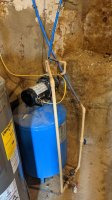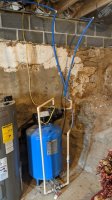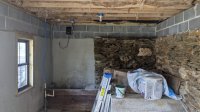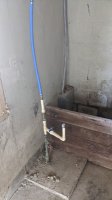Jcwright30
New Member
First my setup (see pics):
- I have a spring fed cistern (600+ gallons). Call this at 600' above sea level.
- This cistern runs down to a bank barn. Call this at 500' above sea level.
- From the barn it feeds into the house. Call this 510' above sea level.
- I have a yard hydrant at the barn which produces massive flow and volume.
- In the house i have a shallow well pump (FP4012-10 flotec) and a pressure tank (FP7120-08).
- Pump is mounted on top of the tank with a pressure switch. There is a pressure gauge at the tee of the tank along with a hose connection for drain-off, etc.
- There is a check valve (questionably not working correctly - I'll get to this later) on the suction side right where the water line enters the house. This check valve is mounted vertically (acceptable) but is about 15 linear feet away from the inlet of the pump.
- All plumbing is 3/4" until i come off of the water heater and tee off to various fixtures.
- Because the cistern is elevated I am receiving a constant pressure in the house of about 28 psi. I have had this pump turned off due to issues - so naturally pressurized works but it's not great. Water pressure throughout the house is lackluster and if you flush a toilet while a shower is running it's almost a trickle. This is my key motivation to get things working again.
- Going back to the head pressure I have - I believe that the check valve isn't doing its job (no fault of the check value itself as it's likely working per spec) but if I turn the pump on and let it pressure up and then immediately close the shutoff valve on the inlet side pressure in the tank holds constant. If i leave that inlet valve open as it should be the water pressure immediately falls down to ~28psi.
- I believe what might be happening is the Cracking pressure on the check valve is likely very low (something likely less than 2 PSI). So when the pump shuts off the check valve never closes and water is back fed until natural head pressure is met (or cut-in of pump)
- I'd love any suggestions or ideas to get this setup working. I think what is particularly unique in this situation is the head pressure.




